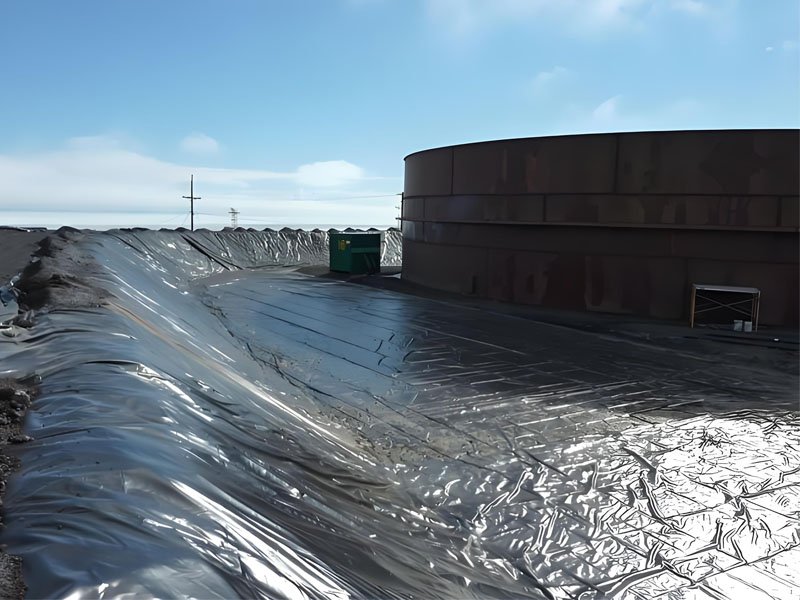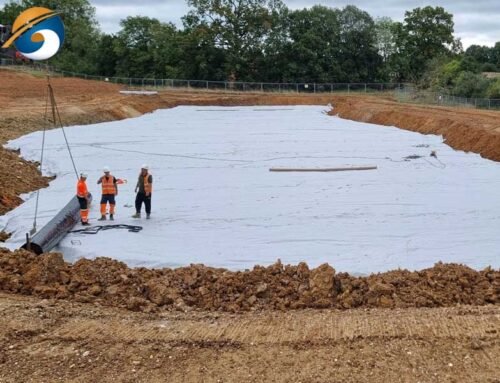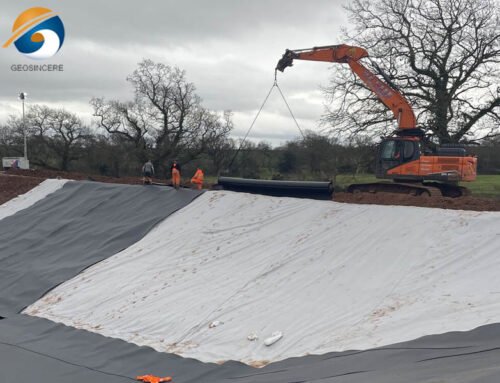HDPE sheet geomembrane liners are made of high-quality polyethylene material and are increasingly popular in the aquaculture industry due to their durability and flexibility. These liners provide a waterproof barrier, greatly reducing water seepage losses common in earthen ponds. Farmers can maintain optimal water levels and quality, which is critical to the health and growth of aquatic species, by choosing a geomembrane liner.
HDPE sheet which also called farm pond anti-seepage geomembrane, but why can it be recognized by more farmers? How To Choose Right HDPE Sheet For Farm Pond? Geosinere Geomembrane is a manufacturer specializing in the production of farming HDPE geomembranes. Let us discuss and learn about it in this article.
1. What Is HDPE Sheet For Farm Pond?
HDPE (High-Density Polyethylene) sheet is a type of thermoplastic made from petroleum. It is known for its high strength-to-density ratio, durability, and resistance to various chemicals. HDPE sheets are commonly used in a wide range of industrial, construction, and consumer applications due to their versatility and performance. Some key properties of HDPE sheets which effect the quality of HDPE sheets include:
- Thickness: Resistant to impact, corrosion, and environmental factors.
- Tensile strength:Usually the requirement is between 15-25 MPa, depending on the project requirements. For more severe conditions, the tensile strength may need to be higher.
- Puncture Resistance: Usually the requirement recommand >240N is better
- UV Resistance:For farming pond, its usually 50% retained after 1600hours to make sure HDPE sheets resist aging or degradation when exposed to sunlight, making them perfect for outdoor farm ponds.
Common applications of HDPE sheets include geomembranes for Farming, landfills, ponds, and reservoirs, construction materials, packaging, and tank fabrication.


2.What are the function of HDPE sheet for farm pond ?
2.1 Water Retention and Evaporation Control
One of the foremost roles of HDPE sheets in farm ponds is their ability to minimize water loss through evaporation. The impermeable nature of these sheets creates a physical barrier that significantly reduces the rate at which water can escape from the pond’s surface. This is particularly crucial in arid regions where water scarcity poses a constant challenge. By maintaining optimal water levels, farmers can ensure a consistent supply for irrigation, livestock consumption, and other vital agricultural activities.
2.2 Erosion Prevention and Soil Stability
HDPE sheets play a pivotal role in preventing soil erosion around the pond’s perimeter. As rainwater or irrigation runoff flows over the landscape, it can carry away topsoil, leading to degradation of the land and loss of fertile ground. By lining the pond with HDPE, farmers create a stable base that helps retain soil structure, thereby preserving the integrity of the surrounding ecosystem and reducing maintenance costs associated with soil replenishment.
2.3 Contaminant Barrier
Another critical function of HDPE sheets is their capacity to act as a barrier against contaminants. In an agricultural setting, there is always a risk of pesticides, herbicides, and fertilizers seeping into water sources, potentially harming both the environment and human health. HDPE liners provide a reliable shield, preventing these substances from penetrating into the pond water and ensuring that it remains clean and safe for use.
2.4 Flexibility and Durability
The flexibility of HDPE sheets makes them ideal for accommodating the natural movement of the earth beneath them without cracking or tearing. This adaptability is essential for long-term sustainability, as it allows the pond lining to withstand temperature fluctuations, seismic activity, and other environmental stresses without compromising its integrity. Furthermore, HDPE’s resistance to UV radiation ensures that the material remains effective even under prolonged exposure to sunlight, extending the lifespan of the pond considerably.
2.5 Cost-Effectiveness
Despite their numerous advantages, HDPE sheets are remarkably cost-effective when compared to traditional pond construction methods such as concrete or clay liners. Their lightweight nature facilitates easy transportation and installation, reducing labor costs. Additionally, their longevity means fewer replacements are required over time, resulting in substantial savings for farmers in the long run.
2.6 Environmental Sustainability
Lastly, the use of HDPE sheets aligns with the principles of environmental sustainability. By minimizing water loss and preventing soil erosion, these materials contribute to the conservation of natural resources. Moreover, their recyclability ensures that they do not contribute to waste accumulation, further promoting eco-friendly practices on farms.
3. How To Choose Right HDPE Sheet For Farm Pond?
3.1 Farm Pond Size and Deep
Farm ponds typically require HDPE liners with 1.0mm to 2.0mm thickness to balance cost and performance effectively. Additionally, thicker liners within this range actively resist punctures from rocks, roots, and farm equipment. Moreover, the enhanced durability of 2.0mm sheets significantly extends the pond’s service life compared to thinner options. Consequently, farmers often choose thicker liners for high-traffic areas or rocky soil conditions. Ultimately, proper thickness selection ensures optimal protection while minimizing long-term maintenance costs.
3.2 Soil Properties
Farm pond construction actively requires careful evaluation of soil acidity and alkalinity before selecting HDPE sheets. Additionally, projects in contaminated areas demand geomembranes with enhanced chemical resistance to withstand corrosive elements. Moreover, soil permeability directly influences material choice since impermeable liners prevent groundwater contamination. Consequently, polluted sites typically need premium HDPE membranes with superior physical and chemical properties. Ultimately, proper geomembrane selection creates effective containment while protecting surrounding ecosystems.
3.3 Biological Species
Aquatic species actively require specific water conditions that directly influence geomembrane selection. Additionally, sensitive fish like trout demand ultra-clean liners that prevent chemical leaching. Moreover, hardy species such as catfish tolerate more versatile liner materials. Consequently, farmers must match liner properties to their fish’s biological needs. Ultimately, proper geomembrane choice ensures optimal water parameters for each species’ health and growth.
3.4 Geomembrane Quality Standards
National standard: GB standard, including GH-1 (ordinary high-density polyethylene geomembrane) and GH-2S (smooth high-density polyethylene geomembrane for environmental protection). The technical indicators of GH-2S are better than GH-1.
American standard: ASTM13 standard, which is currently a globally recognized high-quality standard. It is recommended that geomembranes using this standard have a longer service life.
3.5 Your Budget
When selecting an HDPE geomembrane for an agricultural pond, budget is a key consideration. It’s essential to balance cost with quality to ensure long-term performance and durability. Choosing a reliable brand and manufacturer is crucial to avoid frequent replacements and repairs. GEOSINCERE offers high-quality geomembranes that are known for their strength, UV resistance, and environmental safety. Investing in a trusted product like Geosinere’s geomembrane ensures better results and long-term savings for your agricultural projects. Consulting with an experienced supplier like GEOSINCERE Geomembrane can help ensure the right HDPE liner thickness is selected for a given aquaculture project.


4.What Can Be Done To Extend HDPE Sheet Service Life?
4.1 Regular Inspections
Routine inspections actively identify punctures, tears, or wear patterns before they escalate into major issues. Additionally, these regular checks enable maintenance teams to spot early warning signs like surface abrasions or seam stress. Moreover, prompt detection allows for immediate repairs that prevent small damages from developing into costly leaks. Consequently, this proactive approach significantly extends the liner’s service life while maintaining system integrity. Ultimately, consistent monitoring forms the first line of defense against containment failures and environmental hazards.
4.2 Cleaning Procedure
Regular cleaning actively removes algae growth that could degrade the liner surface over time. Additionally, proper debris removal prevents abrasive particles from causing scratches or punctures during water movement. Moreover, sediment management maintains optimal water quality while reducing stress on the liner material. Consequently, following manufacturer-recommended cleaning methods preserves the liner’s integrity without causing accidental damage. Ultimately, consistent maintenance protects both the liner investment and the aquatic environment it contains.
4.3 Water Level Management
Operators should actively monitor water levels to prevent sudden fluctuations that strain the liner material. Additionally, implementing gradual filling and drainage procedures significantly reduces stress on the liner’s seams and anchoring points. Moreover, controlled water management prevents the liner from overstretching or developing weak spots during rapid level changes. Consequently, these precautions maintain the liner’s structural integrity while avoiding costly repairs. Ultimately, proper water level management ensures long-term performance and protects the containment system’s functionality.
4.4 Choose GEOSINCERE HDPE Sheet
GEOSINCERE is a professional top 3 manufacture which specialized in geomembrane and geosynthetics solutions globally since 2007. Our innovative, high-quality products include geotextiles, geomembrane, geogrid, geocells, geosynthetics clay liners, and drainage boards. Our customers span over 1,000 countries, including the USA, Australia, France, and many more. Geosincere offers not only high-quality geomembrane but also professional installation services. For any inquiries about purchasing or using a geomembrane welding machine, feel free to contact.
5. Summary
In conclusion, selecting the right HDPE sheet for your farm pond is a critical decision that can significantly impact its durability and functionality. To make an informed choice, consider factors such as thickness, UV resistance, environmental conditions, and supplier reputation. By prioritizing these aspects, you can ensure that your farm pond will have a long-lasting and effective liner, enhancing its overall performance and sustainability. Remember to conduct thorough research and consult with GEOSINCERE if needed to find the best HDPE sheet for your specific needs.





